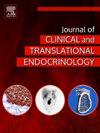DiaBar: Predicting type 2 diabetes remission post-metabolic surgery utilizing mRNA expression profiles from subcutaneous adipose tissue
IF 3.3
Q1 ENDOCRINOLOGY & METABOLISM
Journal of Clinical and Translational Endocrinology
Pub Date : 2025-07-22
DOI:10.1016/j.jcte.2025.100410
引用次数: 0
Abstract
Background
Subcutaneous adipose tissue (SAT) is a metabolic organ, which is involved in the pathogenesis of type 2 diabetes (T2D). Methods to predict diabetes remission after metabolic surgery exist, however their prediction accuracy still needs improvement. We hypothesized, that gene expression profiles in the SAT could predict diabetes remission after metabolic surgery more accurately than any current methods.
Methods
In this retrospective cohort study, we identified individuals who underwent metabolic surgery. We collected SAT biopsies during the surgery and analyzed the expression of HMGA2, PPARG, ADIPOQ and, IL6. The American Diabetes Association criteria were used to define partial and complete remission. Univariate generalized linear models, tree decision algorithms (Exhausted Chaid, CART and Quinlan’s C5 with adaptive boosting) and, multilayer perceptron networks were used to develop classifiers for patients with no, partial or complete remission (DiaBar).
Results
In this study 106 patients were included, 66 (62.3%) patients had T2D the remaining 40 (37.7%) were patients with prediabetes. Complete and partial remission were achieved by 69 (65.1%) and 20 (18.9%) patients respectively. Using a multilayer perceptron, we achieved an overall accuracy of 98.0% (remission: no 100%; partial 90.0%; complete 100%). The validated DiaRem Score was used as the comparative score, which had an overall accuracy for classifying patients with complete, partial or no remission of 74.7%.
Conclusions
Using gene expression profiles from the SAT, we developed the DiaBar test, which accurately predicts diabetes remission after metabolic surgery and seems to be superior to the DiaRem score.
DiaBar:利用皮下脂肪组织mRNA表达谱预测代谢手术后2型糖尿病缓解
背景:皮下脂肪组织(SAT)是一种代谢器官,参与2型糖尿病(T2D)的发病。目前已有预测代谢手术后糖尿病缓解的方法,但预测准确性有待提高。我们假设,SAT中的基因表达谱比目前的任何方法都能更准确地预测代谢手术后糖尿病的缓解。方法在这项回顾性队列研究中,我们确定了接受代谢手术的个体。术中收集SAT活检,分析HMGA2、PPARG、ADIPOQ和IL6的表达。美国糖尿病协会的标准被用来定义部分缓解和完全缓解。单变量广义线性模型、树决策算法(精疲力竭的Chaid、CART和昆兰的C5自适应增强)和多层感知器网络用于开发无缓解、部分缓解或完全缓解(DiaBar)患者的分类器。结果本研究纳入106例患者,其中t2dm 66例(62.3%),前驱糖尿病40例(37.7%)。69例(65.1%)患者完全缓解,20例(18.9%)患者部分缓解。使用多层感知器,我们实现了98.0%的总体准确率(缓解:没有100%;部分的90.0%;完成100%)。采用经过验证的DiaRem评分作为比较评分,对完全缓解、部分缓解或无缓解患者进行分类的总体准确性为74.7%。利用SAT的基因表达谱,我们开发了DiaBar测试,该测试可以准确预测代谢手术后糖尿病的缓解,似乎优于DiaRem评分。
本文章由计算机程序翻译,如有差异,请以英文原文为准。
求助全文
约1分钟内获得全文
求助全文
来源期刊

Journal of Clinical and Translational Endocrinology
ENDOCRINOLOGY & METABOLISM-
CiteScore
6.10
自引率
0.00%
发文量
24
审稿时长
16 weeks
 求助内容:
求助内容: 应助结果提醒方式:
应助结果提醒方式:


